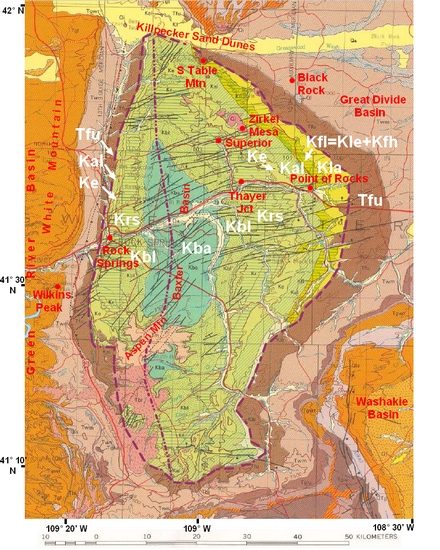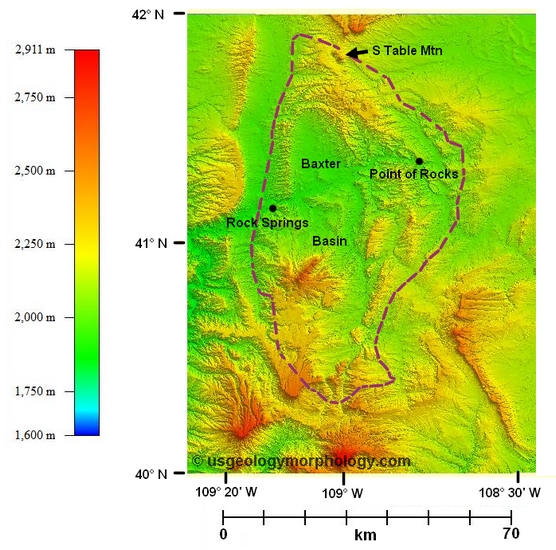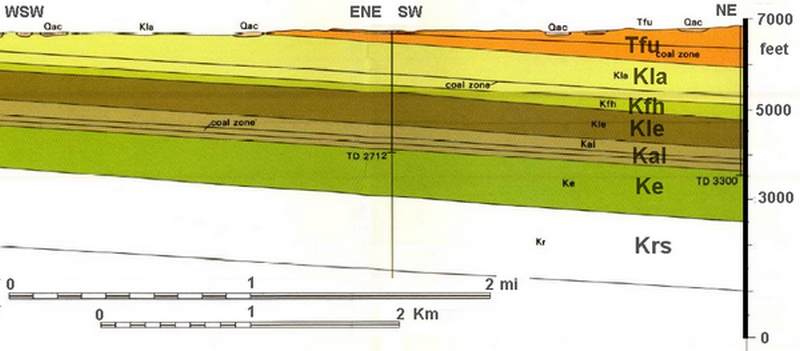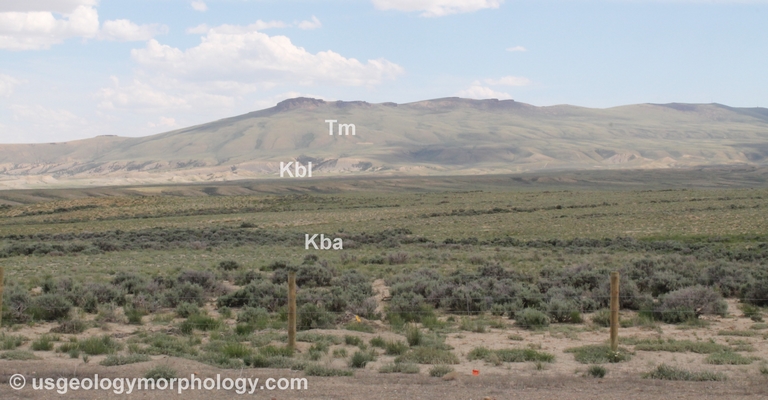Rock Springs Uplift and Adjacent Areas (cont.)
4 Rock Springs Uplift
4.1 Overview
The Rock Springs uplift is one of several sediment-filled areas in southwest Wyoming which were folded into anticlines (uplifts) or synclines (basins, e.g. Washakie basin) during the Laramide orogeny. This orogeny extended from Late Cretaceous time to Paleocene and well into Eocene time. The biggest uplifts brought the Archean basement to the surface (e.g. Wind River Range, Owl Creek Mountains). This orogeny, which followed the Sevier orogeny, more to the west, was the last manifestation of the subduction of the Farallon plate under Laurentia (North America). The subduction angle had become very small (flat-slab subduction), so the subducted slab was not deep enough to induce magmatism, which explains the absence of Mesozoic and Eogene volcanic and plutonic rocks. As noted earlier, it makes more difficult to date these orogenies. One has to rely on relative chronology.
The cross-sections of the eastern and western halves of the Rock Springs anticline (fig. 4-3 and 4-4) show that the dip of the strata is greater on the west side with a major fault (it is a blind fault, i.e. not reaching the present surface). On the eastern side, the curvature of the strata is continuous from the anticline to the Washakie syncline. The rise of the Rock Springs uplift was spread over ~30 Myr in at least five stages of deformation (Roehler, 1992). It began at the end of the Cretaceous, folding the Precambrian (Archean) basement and the sedimentary strata overlying it; then a period of erosion followed before the deposition of the Paleocene Fort Union formation, which was subsequently folded.
Erosion removed all the upper sedimentary layers in the central part of the uplift down to the Baxter shale, which now covers the Baxter basin (fig. 4-1). Harder sandstones (e.g. Rock Springs formation, Ericson sandstone) resisted to erosion on the edges of the uplift, forming center-facing cliffs that protect softer rocks (e.g. Lewis shale) and rise above the Baxter basin (fig. 4-2). In Miocene time, sediment deposition resumed in the southwest of the Rock Springs uplift. Aspen Mountain (fig. 4-5) is one of its eroded remnants.
In the following pages the units exposed at the surface of the uplift are briefly describes and illustrated.

Click on image for full-size zoomable image
Figure 4-1. Geologic map of Rock Springs Uplift, Wyoming.
Purple dashed line: approximate boundaries of Rock Springs uplift. Purple dashed and dot line: anticline axis.
Unit abbreviations (older to younger): Kba-Baxter shale, Kbl-Blair formation, Krs-Rock Springs formation, Ke-Ericson sandstone, Kal-Almond formation, Kfl-Lewis shale and Fox Hills sandstone, undivided (= Kle-Lewis shale + Kfh-Fox Hills sandstone), Kla-Lance formation, Tfu-Fort Union formation.
Unit abbreviations from Love and Christiansen (1985), except Krs (from Jones and Scott, 2010), Kla, Kle and Kfh (from Madden, 1989b). Base map: Love and Christiansen (1985).

Figure 4-2. Elevation map of Rock Springs uplift, Wyoming
Purple dashed line marks the approximate boundaries of Rock Springs uplift. Source: USGS NED. Software: QGIS.

Figure 4-3. Cross-section of the western half of Rock Springs uplift, Wyoming
Cross-section at the latitude of Rock Springs from 109˚ 18' W to 109˚ W. Elevations from sea level. GRB: Green River basin; RSU: Rock Springs uplift; RS: Rock Springs. pC: Precambrian basement (pink). pal: Paleozoic rocks (Cambrian: pink; Mississippian and later: blue). JT: Trias-Jurassic (pale blue). K: Cretaceous. Cretaceous units: Kba-Baxter shale, Kbl-Blair formation, Krs-Rock Springs formation, Ke-Ericson sandstone,
Kfh-Fox Hills sandstone, Kl-Lance formation. Tertiary formations: Tfu-Fort Union formation (Paleocene), Tw-Wasatch formation (lower Eocene). Adapted from the 30x60 min. geologic map of Rock Springs (Jones and Scott, 2010).

Figure 4-4. Cross-section of the eastern edge of Rock Springs uplift, Wyoming
Cross-section from 41˚ 42' 07" N-108˚ 40' 31" W to 41˚ 43' 38" N-108˚ 37' 34" W. Elevations from sea level. Units from bottom to top: Krs-Rock Springs formation, Ke-Ericson sandstone, Kal-Almond formation, Kle-Lewis shale, Kfh-Fox Hills sandstone, Kla-Lance formation, Tfu-Fort Union formation. Adapted from the 7.5 min. geologic map of the Bitter NW quadrangle (Madden, 1989a).

Figure 4-5. Aspen Mountain, Wyoming
View to the south. Also called Quaking Asp Mountain, Aspen Mountain rises over the Baxter basin. It consists of Miocene (Pliocene?) sandstone and claystone.
